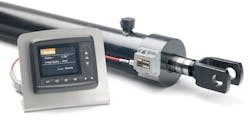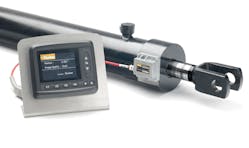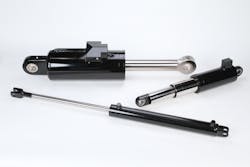Cleveland-based Parker Hannifin Corp. recently announced three engineering enhancements to its hydraulic cylinders that should lengthen operating life, lower costs, cut weight, and enhance overall performance in most any operating environment.
First is the Intellinder, a new position sensor for hydraulic cylinders that reportedly eliminates the drawbacks of other cylinder-sensing technologies. In this design, an optical sensor reads bar codes etched on the rod and sends absolute position data to the controller. It reports position immediately when powered up with no need for calibration. The sensor combines field-proven optics with a proprietary lens that gives high resolution. Reported accuracy is ±0.010 in., repeatability is ±0.0014 in, and hysteresis is ±0.0038 in.
The Intellinder is said to mount easily onto hydraulic cylinders without exposed external sensors or complex linkages, making it suited for challenging outdoor environments. Its sharp bar-code imaging, in turn, permits consistent and predictable control of critical positioning operations. Condition-monitoring capabilities can detect potential cylinder malfunctions before they disrupt operations. And more than one sensor can mount on a cylinder, allowing for redundancy in demanding or critical applications.
Unlike magnetostrictive sensors, the Intellinder requires minimal modifications to a cylinder and eliminates gun drilling the rod. It permits longer strokes and eliminates dead zones associated with magnetostrictive sensors. Should repairs be necessary, the sensor can be quickly removed and replaced without time-consuming disassembly of the entire cylinder.
In contrast with variable-resistance sensors (string pots), Intellinder sensors never require calibration, not even during installation, and it typically provides a longer, trouble-free service life.
When compared with laser gauges, the Intellinder’s optics are unaffected by dirt and fog, which hamper reflective mirrors. Its protected lens resists dust and other contaminants.
It works across a wide temperature range (–40 to 105°C) and handles strokes exceeding 20 ft (6.1 m). It withstands vibration, dirt, corrosives, axial and side loads, and immersion. According to Parker Commercialization Manager, Mike Laurich, the sensor retains signal strength and seal life despite the grueling operating conditions found in waste removal, construction, agricultural, forestry, marine, and military environments.
In another development, the company has launched an environmentally friendly coating that reportedly resists cylinder-rod corrosion up to eight times longer than conventional coatings. Global Shield coating was specifically designed to meet the corrosion, impact, chemical, saltwater, and acidic resistance requirements of mobile and industrial environments while mitigating much of the harmful environmental effects caused by current plating technologies.
Emissions from the Global Shield coating process are well below OSHA personal exposure limits (PEL) and comply with the European market’s Restriction of Hazardous Substances (RoHS) directive and the Registration, Evaluation, Authorisation and Restriction (REACH) initiative.
According to Business Development Manager Dave Crowley, the coating helps meet the demands for an environmentally responsible, corrosion-resistant product that significantly reduces the downtime associated with cylinder repair and replacement. It outperforms engineered hard chrome (EHC) and nitride while matching or exceeding the corrosion resistance of more-costly alternatives. It’s applied at the factory or during aftermarket cylinder maintenance.
The coating is recommended for high-duty-cycle operations where downtime is costly. Typical applications include mining, construction, forestry and material-handling equipment, power-generation systems, refuse trucks, and marine applications.
Finally, to meet the growing demand for light, yet rugged components, the company has introduced Lightraulics. This new generation of hydraulic cylinders and piston accumulators are made from carbon-fiber composites and lightweight alloys. It uses a fully composite barrel, instead of one with a metal liner, which reduces weight over previous versions. They typically weigh about 40% less than comparable steel cylinders, and piston-accumulator versions can be up to 80% lighter.
The construction offers a number of benefits for machine designers, including:
• Exceptional strength and stiffness relative to weight.
• Superior fatigue life compared to metal components.
• High corrosion and chemical resistance.
• Low thermal expansion.
• Nonmagnetic properties.
According to Parker officials, this combination of attributes permits designs and structures which, only a few years ago, would have been impractical or impossible. The cylinders hold particular advantages where weight is critical, including oil and gas, military, marine, and aerospace applications.
Parker’s Lightraulics cylinders are available in bore sizes up to 7.9 in. (200 mm) and operating pressures to 5,500 psi (380 bar). Piston accumulators handle volumes up to 13.2 gallons (50 liters). And, according to the company, composite cylinder and accumulator tubes are manufactured using production techniques which readily permit custom-designed units tailored for specific applications.



